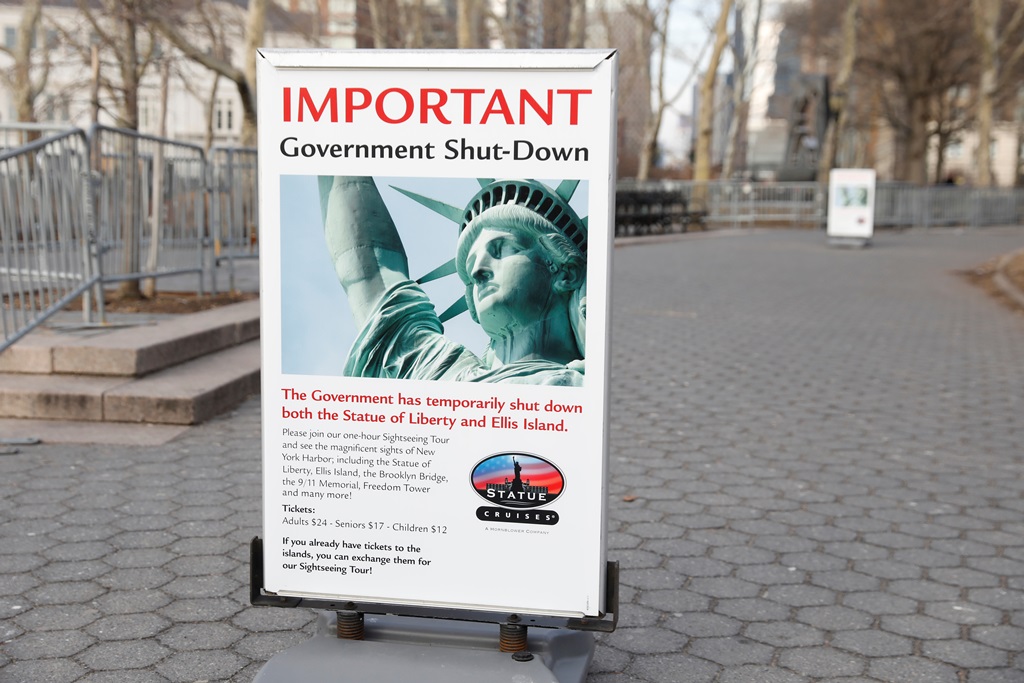Political Consequences of the U.S. Federal Government Shutdown

In December 2018, with both chambers under Republican control, Congress adopted a continuing resolution (CR) to continue to fund the government but which did not include $5.7 billion for the president’s initiative to build additional wall along the border with Mexico. Trump did not sign the CR, however, and that led to a partial shutdown of government institutions. The CR covered about 25% of the federal administration, which then had no additional funding, including the Department of Homeland Security (DHS), Justice, State, Treasury and their subordinate agencies. As a result, about 400,000 employees were furloughed and about the same number had to work without regular pay. Finally, after 35 days of the impasse, on 25 January, and with the House of Representatives now controlled by the incoming Democratic majority, the president made an agreement with Congressional leaders and signed the CR.
Sources of the Dispute
The issue of building a wall on the border with Mexico has been a key point of dispute between the parties since Trump’s campaign for president. Although initially the president announced the construction of a solid concrete wall, he revised his demand based on DHS analysis to steel, slat-type barriers. The “wall” was Trump’s main election promise and is crucial in the context of his efforts to win re-election in 2020.
The significance of this project to the president could help the Democrats put pressure on him on matters important to them, such as extending the federally subsidised healthcare system (Medicaid) or increasing the accessibility of social care. However, the issue of the wall has become so politicised (84% of Democratic Party voters are against this project with 79% of Republicans favouring it) that Democratic politicians now dismiss the possibility of expanding barriers on new sections of the border. In 2006 and 2013, Democrats in Congress supported bills that provided strengthening “border infrastructure.” However, the specifics of the bills were the result of a bipartisan compromise. Today, the Democrats point out that the political context and Trump’s immigration policy do not allow for similar compromise (accusing the administration and its immigration services of brutality and inhumane behaviour towards immigrants). The earlier bills also did not apply to the entire border with Mexico, only sections. On the other hand, DHS officials are convinced that the $5.7 billion dollars the president demands would enable the reinforcement 400 km of key points along the 3,145 km border.
Potential Solutions
There is not much time to work out a compromise before the next automatic shutdown. The Democrats have offered Trump financing of “active” border protection (increasing patrols, drones, cameras, sensors, etc.) and the modernisation of existing barriers. In return, they demand concessions on immigration, such as legal protection for immigrants with Temporary Protected Status or who are covered by the Deferred Action for Childhood Arrival programme, which both include people the Trump administration is seeking to deport. These counter proposals may not be acceptable to the president. During the election campaign, Trump promised to stop irregular migration and impose restrictions on legal immigration. The president may have more to lose in a compromise with the Democrats, such as abandoning actions against immigrants who have already entered the U.S., than if he fails to fulfil his promise to build a wall. In turn, the Democratic Party may harm itself if in the negotiation its leaders work out a compromise with Trump. The party establishment will be criticised by its progressive faction, which demands changes in the ideological basis of the party.
If the disagreement continues, Trump may decide again to not adopt another CR, which will lead again to a shutdown. The presidential administration has left this option open, but increasingly, Republican members of Congress are against it. They say they believe another shutdown will make dialogue between the parties more difficult and will further polarise the political scene. An alternative means for the president to obtain funding for the wall without direct Congressional approval may be to declare a national emergency in connection with a “humanitarian crisis” on the border with Mexico. This would avoid a shutdown and allow for spending on construction of a wall using, for example, money from the Department of Defense construction fund. In this case, it would mean, however, the depletion of funds planned for the expansion of military infrastructure. This has raised concerns among members of Congress in whose districts such investments are planned and may induce them to pressure the president to use instead funds earmarked for infrastructure abroad, including within the European Deterrence Initiative.
The issue of declaring a state of emergency has raised legal doubts because its introduction would directly affect the constitutional checks-and-balances mechanism by transferring some of Congress’s powers to the president (funding). The declaration of a national emergency would also open a new dispute between Trump and Congress and would probably be immediately contested in court, which would delay the start of work on the construction of the barrier.
Conclusions and Prospects
The prolonged shutdown effectively diverted the attention of media from the Special Counsel Robert Mueller’s investigation, which despite the lack of financing for the Department of Justice, has not stopped working. This was beneficial for Trump but he and the Republicans turned out to be the losers of the shutdown. In polls, 56% of Americans blame Trump and the GOP for the crisis while the Republicans’ favourability rating has dropped from 45% to 37%. Democrats are blamed by 34% of those polled but their favourability remained at 45%. The public’s perception is similar to that after the government shutdown in early 2018, although then the Democrats were also criticised by their voters.
The record duration of the recent shutdown (35 days) has led to a discussion about the validity of using it as an instrument of pressure. Congress probably will start work on bills to abolish its use. Shutdowns can be limited by federal administration funding based on annual budgets rather than the short-term CRs.
The lack of benefits from the long shutdown raised tensions within the Republican Party. Both the president and Senate Majority Leader Mitch McConnell were criticised by some Republican members of Congress. McConnell says he will try to avoid another rejection of a CR. The Republicans remain divided and support for the president’s actions is not as clear among the party’s politicians as Trump himself seems to expect. On the other hand, the Democrats’ attempts to end the shutdown demonstrated their unity in actions against Trump. It served as a preview of the opposition’s capability and the next two years, at least, of what the president can expect from the House of Representatives, fully in Democratic control.
The tensions between the president and the Democrats go beyond domestic politics and could mean Congress’s greater involvement in international affairs. The Democrats may pay more attention to U.S. tensions with the EU or the president’s threats to withdraw from NATO structures. The Democrats may strive to adopt laws to limit the president’s powers and increase Congressional control, for example, in connection with the sale of arms to foreign partners or the use of armed forces. In turn, members of the presidential administration may be subpoenaed to testify before Congress in hearings on matters such as the withdrawal of troops from Syria and Afghanistan, withdrawal from the Paris climate agreement, or the future of the free-trade agreement with South Korea (KORUS) and the U.S. military presence on the Korean Peninsula.
The strong polarisation of the American political scene is also important for allied states, including Poland, to consider. Deepening relations with the U.S. should be sought with the cooperation and support of both political parties so that initiatives, especially those relevant to Poland’s interests, do not suffer as a result of the current disputes. The politicisation of new initiatives given the internal U.S. disputes reduces the chance of their implementation.


